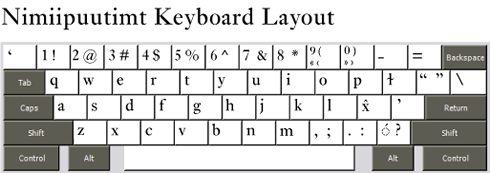
Although one font can contain all of the glyphs necessary for viewing Native languages on a computer, a specific keyboard is required to type each language. Every written language uses one or more “orthographies” and each language community builds its orthography to suit its own sounds, politics, and aesthetics.
An orthography is an inventory of individual letters, characters, and symbols which are used to write the language. Spanish generally leaves out the letters k and w but adds á é í ñ ó ú and ü. For example, all of the modern languages of Western Europe use the Latin script (sometimes called Roman Orthography), but each one omits letters that are not necessary for that language and extends the script by adding diacritics (accents) or entirely new letters. The entire list of glyphs employed by a language is called a “repertoire”. Dene Zhatié does not use the letters f p q and v but adds the characters ą á ą́ ę é ę́ į í į́ ł ǫ ó ǫ́ ų ú ų́ and ʔ. Native languages of the Americas which use the Latin script also have specific repertoires, omitting letters which represent sounds not in the language, and adding diacritics or new characters when necessary.
In some languages, groups of two or three glyphs qualify as one “letter”, as in the Hul’qumin’um’ word ts’ul’ts’s, which in listed in dictionaries as having only five letters: ts’-u-l’-ts’-s. Within the Latin script, repertoires vary significantly. For this reason, most languages need their own keyboard layouts.
Most of the keyboard layouts on this site have been designed to run on Windows XP / Vista and Mac OS X systems without the installation of additional third party software. However, some of the Windows keyboards (syllabics keyboards especially) require Tavultesoft Keyman.The Keyman is included in all keyboard layout downloads, so you need not install Keyman separately. Here is an example of a typical Languagegeek keyboard layout, here for the Nimiipuutimt Language:

The organisation of glyphs (or mapping) on the Roman keyboards follows the US English keyboard found on most computers used by Native people. A few keyboard layouts for languages spoken in Quebec follow the French Canadian map. If you use a different Roman keyboard, such as German, you will unfortunately find that the punctuation marks are found on their US value keys.
To download keyboards and view the keymaps, use the menu at the top of this page. Select “Language”. There is also a list of all keyboards on this site.
